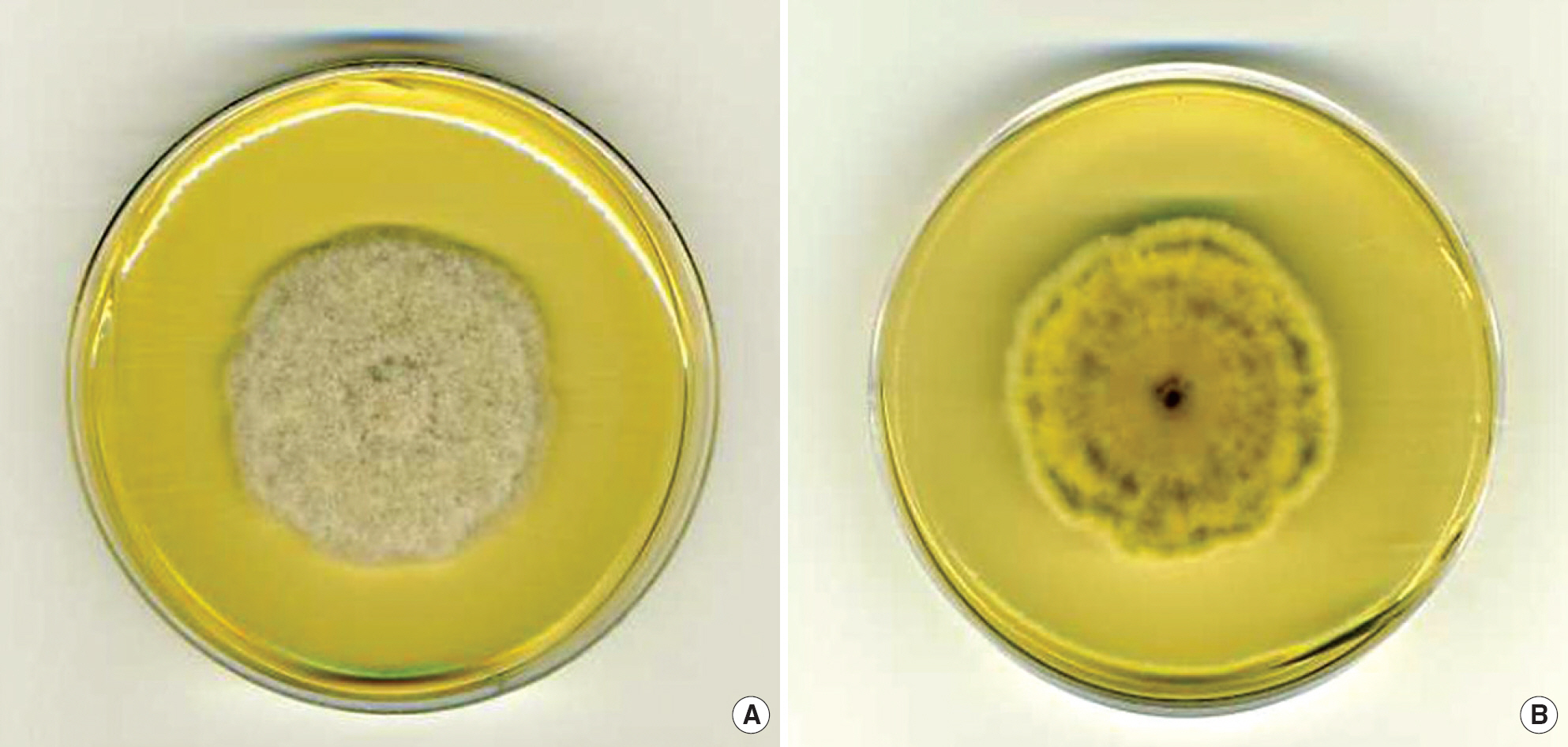Korean J Lab Med.
2008 Aug;28(4):307-311. 10.3343/kjlm.2008.28.4.307.
A Case of Scedosporium apiospermum Keratitis Confirmed by a Molecular Genetic Method
- Affiliations
-
- 1Department of Laboratory Medicine, Yonsei University College of Medicine, Seoul, Korea. hjkim12@yuhs.ac
- KMID: 854894
- DOI: http://doi.org/10.3343/kjlm.2008.28.4.307
Abstract
- A 54-yr-old male, who was treated by chemotherapy for gastric cancer 15 months ago, presented to Yongdong Severance Hospital, Seoul, with complaints of pain in his right eye caused by a foreign body from the ground in the previous week. He had been treated with topical and oral antibacterial in addition to antifungal agents, but did not show significant clinical improvement. After a positive corneal culture with mold, topical amphotericin B was added to the initial regimen. The mold was identified as Scedosporium apiospermum by macroscopic and microscopic morphologies and the nucleotide sequences of a fungal PCR product showing 99% homology with those of S. apiospermum (EF151349). He recovered with good results at 25 days after corneal epithelial debridement. The early diagnosis of S. apiospermum keratitis is very important for proper treatment. It is recommended that molecular diagnostic methods such as fungal PCR and sequencing be done with conventional cultures whenever a fungal infection is suspected.
MeSH Terms
-
Amphotericin B/therapeutic use
Anti-Bacterial Agents/therapeutic use
Antifungal Agents/therapeutic use
Cornea/microbiology
Drug Therapy, Combination
Eye Infections, Fungal/*diagnosis/microbiology
Humans
Keratitis/*diagnosis/microbiology
Male
Middle Aged
Polymerase Chain Reaction
Scedosporium/genetics/growth & development/*isolation & purification
Sequence Analysis, DNA
Figure
Cited by 2 articles
-
A Case of Fungal Keratitis Scedosporium apiospermum
Saem Lee, Dong Wook Lee, Hye Soo Lee, In Cheon You
J Korean Ophthalmol Soc. 2013;54(4):675-679. doi: 10.3341/jkos.2013.54.4.675.Identification of Bacterial and Fungal Isolates by Sequence Analysis of 16S rRNA and Internal Transcribed Spacer
Younhee Park, Hee Bong Shin, Chang Ki Kim, Kyoung Ho Roh, Jong Hwa Yum, Dongeun Yong, Seok Hoon Jeong, Kyungwon Lee
Korean J Clin Microbiol. 2010;13(1):34-39. doi: 10.5145/KJCM.2010.13.1.34.
Reference
-
1.Verweij PE., Brandt ME. Aspergillus, Fusarium, and other opportunistic moniliaceous fungi. Murray PR, Baron EJ, editors. Manual of clinical microbiology. 9th ed.Washington DC: ASM press;2007. p. 1821–2.2.Cortez KJ., Roilides E., Quiroz-Telles F., Meletiadis J., Antachopoulos C., Knudsen T, et al. Infections caused by Scedosporium spp. Clin Microbiol Rev. 2008. 21:157–97.3.Chung JW., Park SJ., Sung H., Kim MN., Kim BS., Lee SG. A case of disseminated infection due to Scedosporium apiospermum in a livertransplantation recipient. Korean J Lab Med. 2005. 25:421–4. (정재우, 박숙자, 성흥섭, 김미나, 김범수, 이승규. 간이식후발생한 Scedosporium apiospermum 파종성감염 1예. 대한진단검사의학회지 2005;25: 421-4.).4.Thomas PA. Mycotic keratitis–an underestimated mycosis. J Med Vet Mycol. 1994. 32:235–56.5.Wu Z., Ying H., Yiu S., Irvine J., Smith R. Fungal keratitis caused by Scedosporium apiospermum: report of two cases and review of treatment. Cornea. 2002. 21:519–23.6.White TJ., Bruns T., Lee S., Tayor J. Amplification and direct sequencing of fungal ribosomal RNA genes for phylogenetics. Innins MA, Gelfand DH, editors. PCR protocols: A guide to methods and applications. San Diego: Academic Press;1990. p. 315–22.
Article7.Diaz-Valle D., Benitez del Castillo JM., Amor E., Toledano N., Carretero MM., Diaz-Valle T. Severe keratomycosis secondary to Scedosporium apiospermum. Cornea. 2002. 21:516–8.8.Rosa RH Jr., Miller D., Alfonso EC. The changing spectrum of fungal keratitis in south Florida. Ophthalmology. 1994. 101:1005–13.
Article9.Xie L., Zhong W., Shi W., Sun S. Spectrum of fungal keratitis in north China. Ophthalmology. 2006. 113:1943–8.
Article10.Hahn YH., Hahn TW., Tchah H., Choi SH., Choi KY., Kim KS, et al. Epidemiology of infectious keratitis (II): a multi-center study. J Korean Ophthalmol Soc. 2001. 42:247–65. (한영호, 한태원, 차흥원, 최시환, 최기용, 김기산등. 감염성각막염의역학조사(II): 다병원연구. 대한안과학회지 2001;42: 247-65.).11.Ksiazek SM., Morris DA., Mandelbaum S., Rosenbaum PS. Fungal panophthalmitis secondary to Scedosporium apiospermum (Pseudallescheria boydii) keratitis. Am J Ophthalmol. 1994. 118:531–3.12.Moshirfar M., Welling JD., Feiz V., Holz H., Clinch TE. Infectious and noninfectious keratitis after laser in situ keratomileusis occurrence, management, and visual outcomes. J Cataract Refract Surg. 2007. 33:474–83.13.Robin JB., Arffa RC., Avni I., Rao NA. Rapid visualization of three common fungi using fluorescein-conjugated lectins. Invest Ophthalmol Vis Sci. 1986. 27:500–6.14.Lamps CA., Oeltmann TN., Collins MJ Jr.., Robinson RD., Logan RA., Head WS, et al. Development of a chitin assay for the quantification of fungus. Curr Eye Res. 1995. 14:637–41.
Article15.Okhravi N., Adamson P., Mant R., Matheson MM., Midgley G., Towler HM, et al. Polymerase chain reaction and restriction fragment length polymorphism mediated detection and speciation of Candida spp causing intraocular infection. Invest Ophthalmol Vis Sci. 1998. 39:859–66.16.Mancini N., Ossi CM., Perotti M., Carletti S., Gianni C., Paganoni G, et al. Direct sequencing of Scedosporium apiospermum DNA in the diagnosis of a case of keratitis. J Med Microbiol. 2005. 54:897–900.17.Meletiadis J., Meis JF., Mouton JW., Rodriquez-Tudela JL., Donnelly JP., Verweij PE. In vitro activities of new and conventional antifungal agents against clinical Scedosporium isolates. Antimicrob Agents Chemother. 2002. 46:62–8.18.National Committee for Clinical Laboratory Standards. Reference method for broth dilution antifungal susceptibility testing of filamentous fungi. Approved standard M38-A. Wayne, PA: National Committee for Clinical Laboratory Standards;2002.19.Nesky MA., McDougal EC., Peacock Jr JE. Pseudallescheria boydii brain abscess successfully treated with voriconazole and surgical drainage: case report and literature review of central nervous system pseudallescheriasis. Clin Infect Dis. 2000. 31:673–7.20.Linares Sicilia MJ., Santos Lacomba M., Solis Cuesta F., SanchezPedraza R., Nievas Gomez T., Casal Roman M. Scedosporium apiospermum keratitis. Rev Iberoam Micol. 2003. 20:68–70.
- Full Text Links
- Actions
-
Cited
- CITED
-
- Close
- Share
- Similar articles
-
- A Case of Fungal Keratitis Scedosporium apiospermum
- A Case of Cutaneous Abscess Due to Scedosporium apiospermum
- A Case of Cutaneous Scedosporium apiospermum Infection
- A Case of Scedosporium Apiospermum Pneumonia in an Immunocompetent Patient
- A Case of Localized Skin Infection Due to Scedosporium Apiospermum



